Thermo-Elasto-Hydrodynamic Characteristics Analysis of Journal Microbearing Lubricated with Rarefied Gas
Abstract
1. Introduction
2. Methodology
3. Modified Energy Equation and Microbearing Flexibility
- (1)
- The microbearing pad is considered to be a three-dimensional cylindrical structure of finite length enclosed in a rigid housing, and the nodal displacement components on the outer surface of bearing pad that are in contact with the housing are taken as zero.
- (2)
- The bearing pad is subjected to the distributed load P, namely the pressure load is acting on all the nodes of microbearing working surface according to a given sequence of nodes on the bearing surface.
- (3)
- The radial displacements of the pad–housing interface are continuous and periodic in the circumferential direction because the starting and ending planes in the finite element model of the microbearing are identical.
4. Results and Discussion
4.1. Steady-State Characteristics
4.2. Dynamic Stiffness and Damping Coefficients
5. Conclusions
- (1)
- The peak temperature occurs at the vicinity of the location where the minimum gas film thickness appears. The temperature of the lubricant increases more significantly at higher eccentricity ratios than at higher speeds, and the elastic bearing pad is found to decrease the maximum gas film temperature.
- (2)
- As the eccentricity ratio and shaft rotation speed increase, both the load capacity and friction coefficient increase monotonically, while the attitude angle becomes smaller as the eccentricity ratio increases. The presence of thermal and elastic deformation effects increases the load capacity and friction coefficient because of the promoted gas viscosity and the enhanced aerodynamic phenomenon as well as the decreased rarefaction effect.
- (3)
- The direct stiffness coefficients increase and the direct damping coefficients begin to decrease for higher values of perturbation frequency, eccentricity ratio and rotor rotation speed. The direct stiffness coefficients increase with the increase of lubricant temperature; however, its effect on direct damping coefficients is reversed. The impact of elastic distortion of the bounding solids on dynamic coefficients in thermo-elasto-aerodynamic analysis is similar to the thermo-aerodynamic results with reduced elastic modulus. The thermo-elasto-aerodynamic behavior in the micro gas bearing is important to know to fundamentally understand the lubrication conditions in the bearing–journal pair.
Author Contributions
Funding
Conflicts of Interest
References
- Kim, D.; Lee, S.; Bryant, M.D.; Ling, F.F. Hydrodynamic Performance of Gas Microbearings. J. Tribol. 2004, 126, 711–718. [Google Scholar] [CrossRef]
- Barisik, M.; Beskok, A. “Law of the nano-wall” in nano-channel gas flows. Microfluid. Nanofluidics 2016, 20, 46. [Google Scholar] [CrossRef]
- Li, N.; Wang, Z.; Zhang, Z. Influence of plant structure and flow path interactions on the plant purification system: Dynamic evolution of the SO2 pollution. Environ. Sci. Pollut. Res. 2018, 25, 35099–35108. [Google Scholar] [CrossRef] [PubMed]
- Anand, G.; Saxena, P. A review on graphite and hybrid nano-materials as lubricant additives. IOP Conf. Ser. Mater. Sci. Eng. 2016, 149, 012201. [Google Scholar] [CrossRef]
- Rana, A.; Torrilhon, M.; Struchtrup, H. A robust numerical method for the R13 equations of rarefied gas dynamics: Application to lid driven cavity. J. Comput. Phys. 2013, 236, 169–186. [Google Scholar] [CrossRef]
- Hssikou, M.; Baliti, J.; Alaoui, M. Continuum Analysis of Rarefaction Effects on a Thermally Induced Gas Flow. Math. Probl. Eng. 2019, 2019, 1–14. [Google Scholar] [CrossRef]
- Wang, Z.; Wang, X.; Tong, Y.; Wang, Y. Impact of structure and flow-path on in situ synthesis of AlN: Dynamic microstructural evolution of Al-AlN-Si materials. Sci. China Mater. 2018, 61, 948–960. [Google Scholar] [CrossRef]
- Li, L.; Zhang, D.; Xie, Y. Effect of misalignment on the dynamic characteristic of MEMS gas bearing considering rarefaction effect. Tribol. Int. 2019, 139, 22–35. [Google Scholar] [CrossRef]
- Bi, C.; Han, D.; Yang, J. The frequency perturbation method for predicting dynamic coefficients of supercritical carbon dioxide lubricated bearings. Tribol. Int. 2020, 146, 106256. [Google Scholar] [CrossRef]
- Wang, Z.; Zhang, Y.; Jiang, S.; Wang, J.; Du, D.; Wang, X.; Wang, Y. The red deer antler: Bioinspired design of an Al Si composite with a fenestrated network-particle structure. J. Mater. 2020, 6, 545–556. [Google Scholar] [CrossRef]
- Beskok, A.; Karniadakis, G.E. Report: A model for flows in channels, pipes, and ducts at micro and nano scales. Microscale Thermophys. Eng. 1999, 3, 43–77. [Google Scholar]
- Rao, X.-J.; Chang, K.-M.; Li, W.-L. Characteristics of micro-gas journal bearings based on kinetic theory. Tribol. Int. 2011, 44, 241–247. [Google Scholar] [CrossRef]
- Hughes, W.F.; Osterle, F. Temperature Effects in Journal Bearing Lubrication. ASLE Trans. 1958, 1, 210–212. [Google Scholar] [CrossRef]
- Mccallion, H.; Yousif, F.; Lloyd, T. The Analysis of Thermal Effects in a Full Journal Bearing. J. Tribol. 1970, 92, 578. [Google Scholar] [CrossRef]
- Ezzat, H.A.; Rohde, S.M. A Study of the Thermohydrodynamic Performance of Finite Slider Bearings. J. Lubr. Technol. 1973, 95, 298–307. [Google Scholar] [CrossRef]
- Seireg, A.; Ezzat, H. Thermohydrodynamic Phenomena in Fluid Film Lubrication. J. Lubr. Technol. 1973, 95, 187–194. [Google Scholar] [CrossRef]
- Paranjpe, R.S.; Han, T. A study of the thermohydrodynamic performance of steadily loaded journal bearings. Tribol. Trans. 1994, 37, 679–690. [Google Scholar] [CrossRef]
- Zhang, S.; Bogy, D. A heat transfer model for thermal fluctuations in a thin slider/disk air bearing. Int. J. Heat Mass Transf. 1999, 42, 1791–1800. [Google Scholar] [CrossRef]
- Jang, J.Y.; Khonsari, M.M. Design of bearings on the basis of thermohydrodynamic analysis. Proc. Inst. Mech. Eng. Part J J. Eng. Tribol. 2004, 218, 355–363. [Google Scholar] [CrossRef]
- Singhal, S.; Khonsari, M.M. A simplified thermohydrodynamic stability analysis of journal bearings. Proc. Inst. Mech. Eng. Part J J. Eng. Tribol. 2005, 219, 225–234. [Google Scholar] [CrossRef]
- Stevanović, N.D.; Milićev, S.S. A constant wall temperature microbearing gas flow. FME Trans. 2010, 38, 71–77. [Google Scholar]
- Zhang, X.-Q.; Wang, X.; Zhang, Y.-Y. Non-linear dynamic analysis of the ultra-short micro gas journal bearing-rotor systems considering viscous friction effects. Nonlinear Dyn. 2013, 73, 751–765. [Google Scholar] [CrossRef]
- Zhang, X.; Wang, X.-L.; Si, L.; Liu, Y.-D.; Shi, W.-T.; Xiong, G.-J. Effects of Temperature on Nonlinear Dynamic Behavior of Gas Journal Bearing-rotor Systems for Microengine. Tribol. Trans. 2016, 59, 944–956. [Google Scholar] [CrossRef]
- Zhang, X.; Chen, Q.; Liu, J. Hydrodynamic Behaviors of the Gas-Lubricated Film in Wedge-Shaped Microchannel. J. Tribol. 2016, 138, 031701. [Google Scholar] [CrossRef]
- Zhang, X.; Chen, Q.; Liu, J. Steady Characteristics of High-Speed Micro-Gas Journal Bearings With Different Gaseous Lubricants and Extreme Temperature Difference. J. Tribol. 2017, 139, 021703. [Google Scholar] [CrossRef]
- Rohde, S.M.; Oh, K.P. A Thermoelastohydrodynamic Analysis of a Finite Slider Bearing. J. Tribol. 1975, 97, 450. [Google Scholar] [CrossRef]
- Khonsari, M.M.; Wang, S.H. On the Fluid-Solid Interaction in Reference to Thermoelastohydrodynamic Analysis of Journal Bearings. J. Tribol. 1991, 113, 398–404. [Google Scholar] [CrossRef]
- Piffeteau, S.; Souchet, D.; Bonneau, D. Influence of Thermal and Elastic Deformations on Connecting-Rod Big End Bearing Lubrication Under Dynamic Loading. J. Tribol. 2000, 122, 181–191. [Google Scholar] [CrossRef]
- Zhang, C.; Yi, Z.; Zhang, Z. THD Analysis of High Speed Heavily Loaded Journal Bearings Including Thermal Deformation, Mass Conserving Cavitation, and Turbulent Effects. J. Tribol. 2000, 122, 597–602. [Google Scholar] [CrossRef]
- Bouyer, J.; Fillon, M. On the Significance of Thermal and Deformation Effects on a Plain Journal Bearing Subjected to Severe Operating Conditions. J. Tribol. 2004, 126, 819–822. [Google Scholar] [CrossRef]
- Kuznetsov, E.; Glavatskih, S.; Fillon, M. THD analysis of compliant journal bearings considering liner deformation. Tribol. Int. 2011, 44, 1629–1641. [Google Scholar] [CrossRef]
- Kuznetsov, E.; Glavatskih, S. Dynamic characteristics of compliant journal bearings considering thermal effects. Tribol. Int. 2016, 94, 288–305. [Google Scholar] [CrossRef]
- Bai, S.; Ma, C.; Peng, X.; Wen, S. Thermoelastohydrodynamic Behavior of Gas Spiral Groove Face Seals Operating at High Pressure and Speed. J. Tribol. 2015, 137, 021502. [Google Scholar] [CrossRef]
- Linjamaa, A.; Lehtovaara, A.; Larsson, R.; Kallio, M.; Söchting, S. Modelling and analysis of elastic and thermal deformations of a hybrid journal bearing. Tribol. Int. 2018, 118, 451–457. [Google Scholar] [CrossRef]
- Yang, J.; Palazzolo, A. Three-Dimensional Thermo-Elasto-Hydrodynamic Computational Fluid Dynamics Model of a Tilting Pad Journal Bearing—Part I: Static Response. J. Tribol. 2019, 141, 061702. [Google Scholar] [CrossRef]
- Yang, J.; Palazzolo, A. Three-Dimensional Thermo-Elasto-Hydrodynamic Computational Fluid Dynamics Model of a Tilting Pad Journal Bearing—Part II: Dynamic Response. J. Tribol. 2019, 141, 061703. [Google Scholar] [CrossRef]
- Hwang, C.C.; Fung, R.F.; Yang, R.F.; Weng, C.I.; Li, W.L. A new modified Reynolds equation for ultrathin film gas lubrication. Magn. IEEE Trans. 1996, 32, 344–347. [Google Scholar] [CrossRef]
- Duwensee, M. Numerical and Experimental Investigations of the Head/Disk Interface. Ph.D. Thesis, UC San Diego, San Diego, CA, USA, 2007. [Google Scholar]
- Wu, Y.; Yang, L.; Xu, T.; Xu, H. Interactive Effects of Rarefaction and Surface Roughness on Aerodynamic Lubrication of Microbearings. Micromachines 2019, 10, 155. [Google Scholar] [CrossRef]
- Yu, L. A generalized solution of elasto-aerodynamic lubrication for aerodynamic compliant foil bearings. Sci. China Ser. E Eng. Mater. Sci. 2005, 48, 414–429. [Google Scholar] [CrossRef]
- Lihua, Y.; Huiguang, L.; Lie, Y. Dynamic stiffness and damping coefficients of aerodynamic tilting-pad journal bearings. Tribol. Int. 2007, 40, 1399–1410. [Google Scholar] [CrossRef]
- Wu, Y.; Yang, L.; Xu, T.; Xu, H. Combined Effect of Rarefaction and Effective Viscosity on Micro-Elasto-Aerodynamic Lubrication Performance of Gas Microbearings. Micromachines 2019, 10, 657. [Google Scholar] [CrossRef]
- Majumdar, B.C. The thermohydrodynamic solution of oil journal bearings. Wear 1975, 31, 287–294. [Google Scholar] [CrossRef]
- Pinkus, O.; Bupara, S.S. Adiabatic Solutions for Finite Journal Bearings. J. Lubr. Technol. 1979, 101, 492–496. [Google Scholar] [CrossRef]
- Linjamaa, A.; Lehtovaara, A.; Kallio, M.; Söchting, S. Modelling and Analysis of Elastic and Thermal Deformations of a Hydrodynamic Radial Journal Bearing. Key Eng. Mater. 2016, 674, 127–132. [Google Scholar] [CrossRef]
- Orr, D.J. Macro-Scale Investigation of High-Speed Gas Bearings for MEMS Devices. Ph.D. Thesis, Massachusetts Institute of Technology, Cambridge, MA, USA, 2000. [Google Scholar]
- Lee, Y.-B.; Kwak, H.-D.; Kim, C.-H.; Lee, N.-S. Numerical prediction of slip flow effect on gas-lubricated journal bearings for MEMS/MST-based micro-rotating machinery. Tribol. Int. 2005, 38, 89–96. [Google Scholar] [CrossRef]
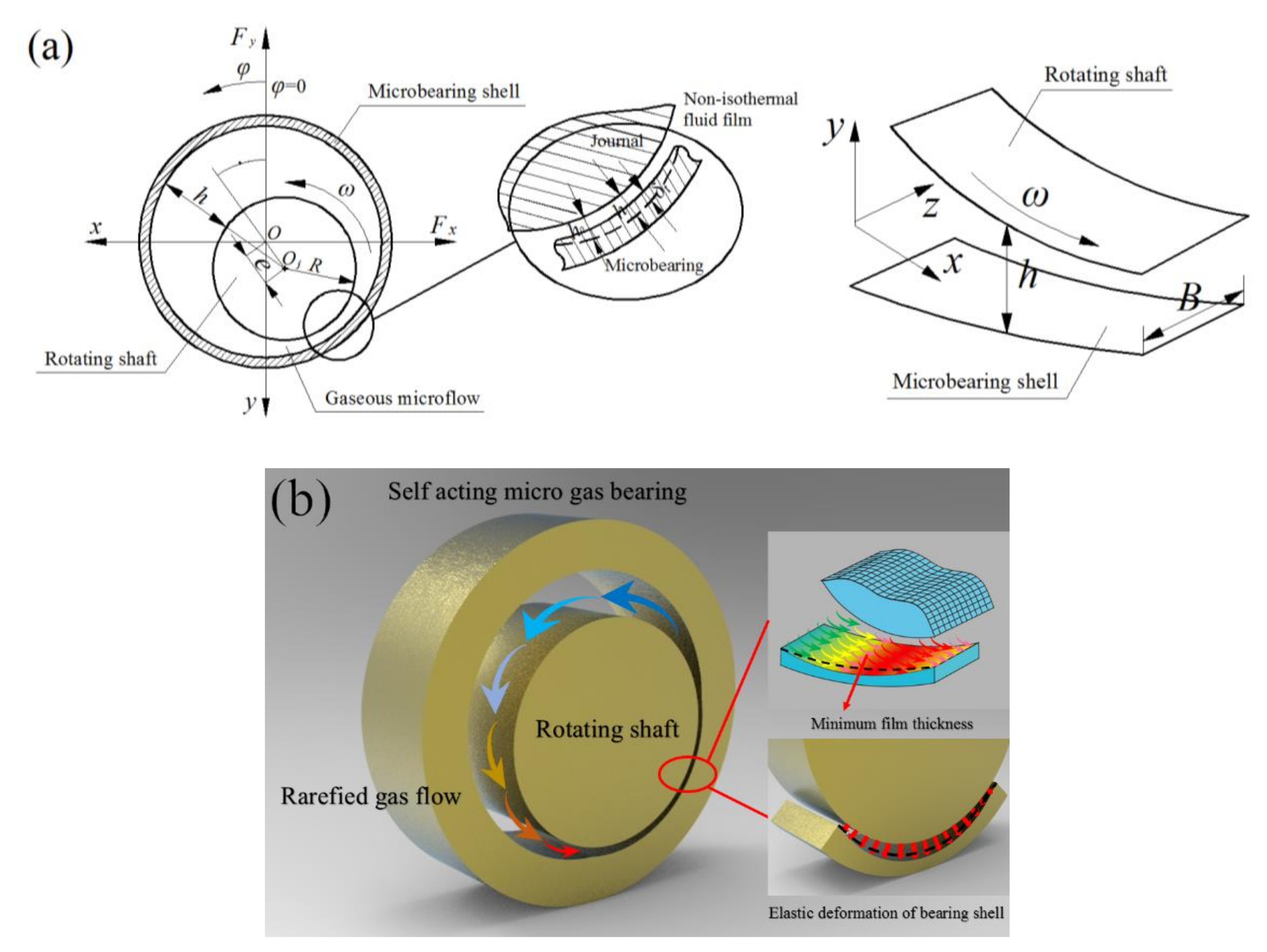
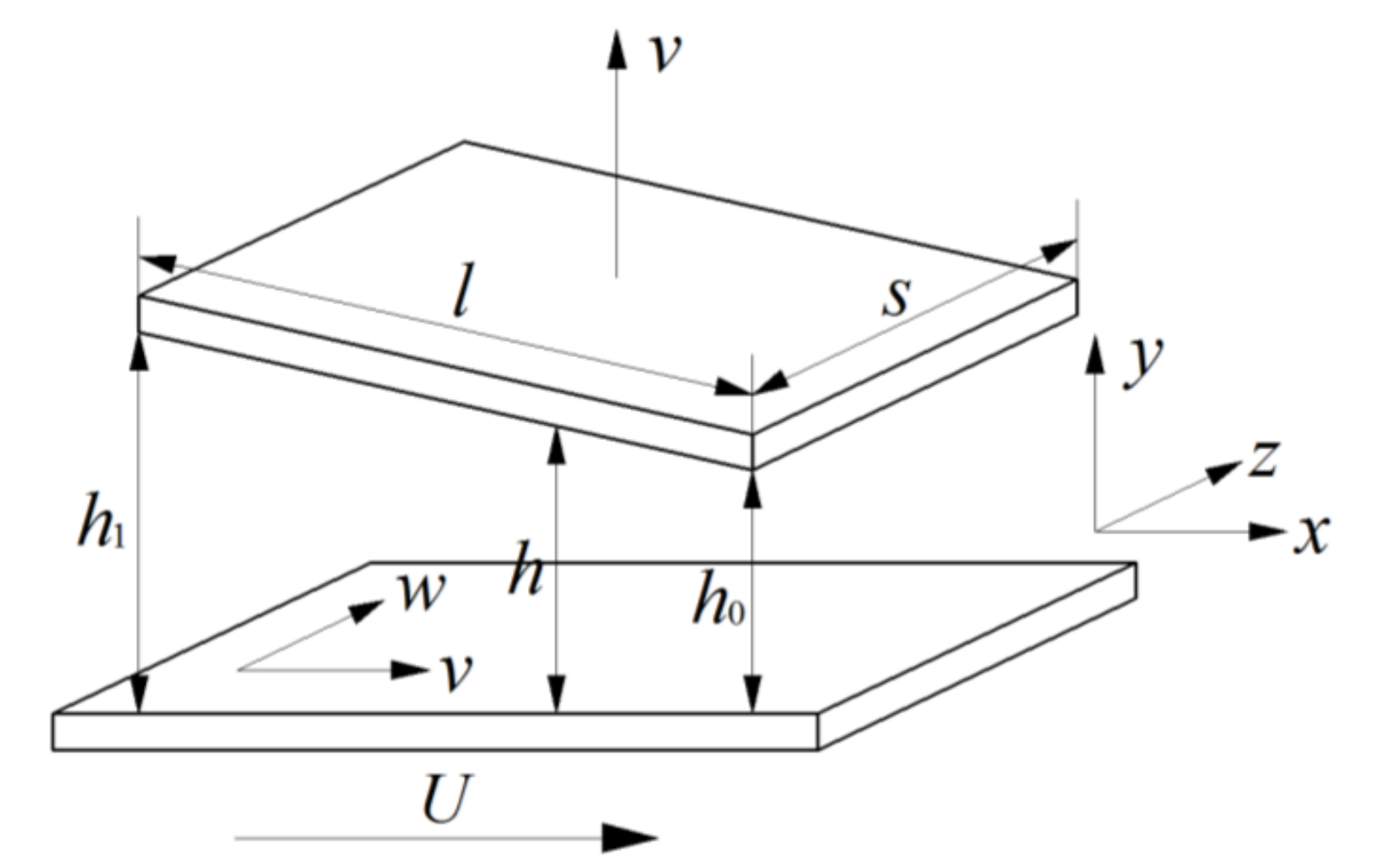

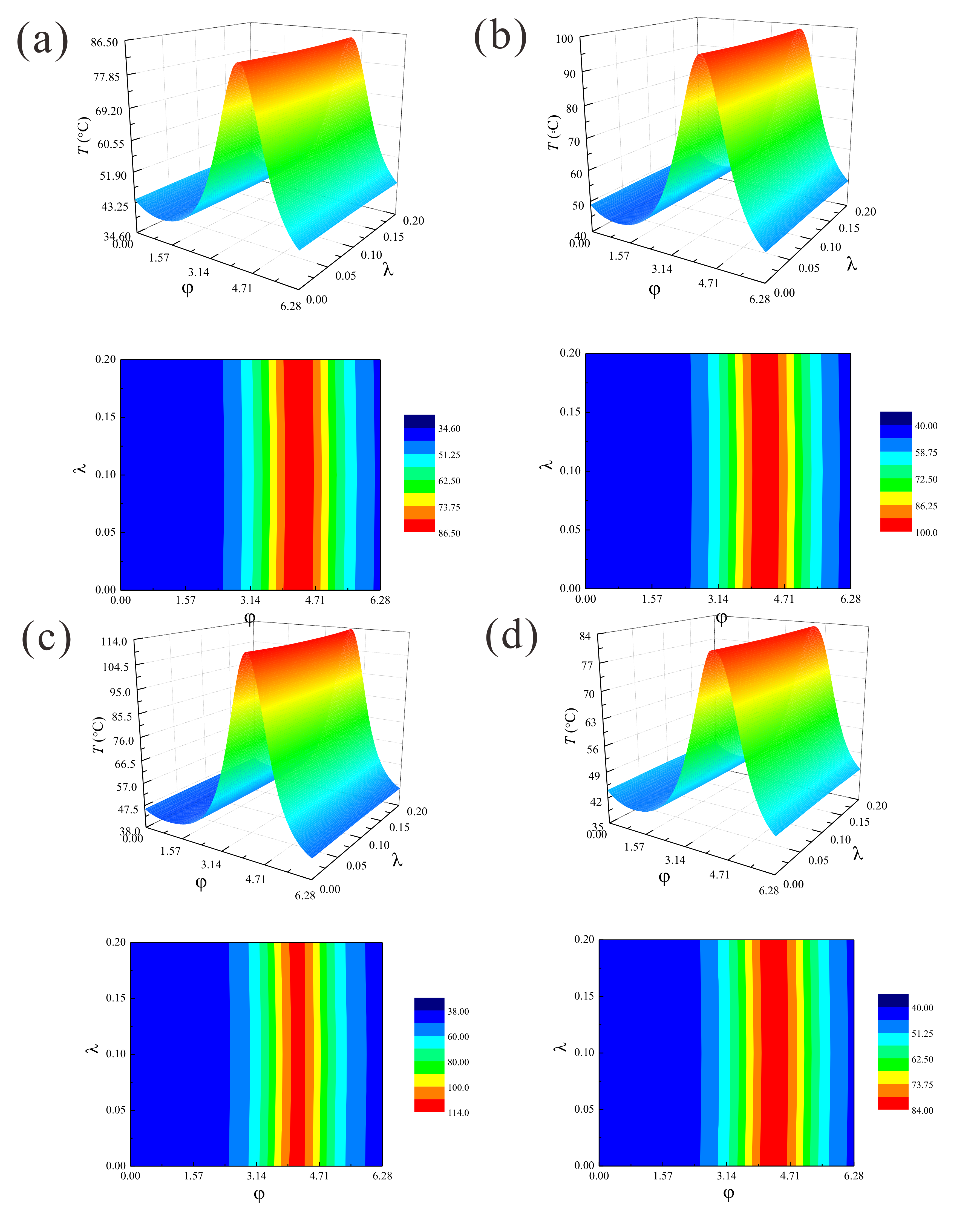
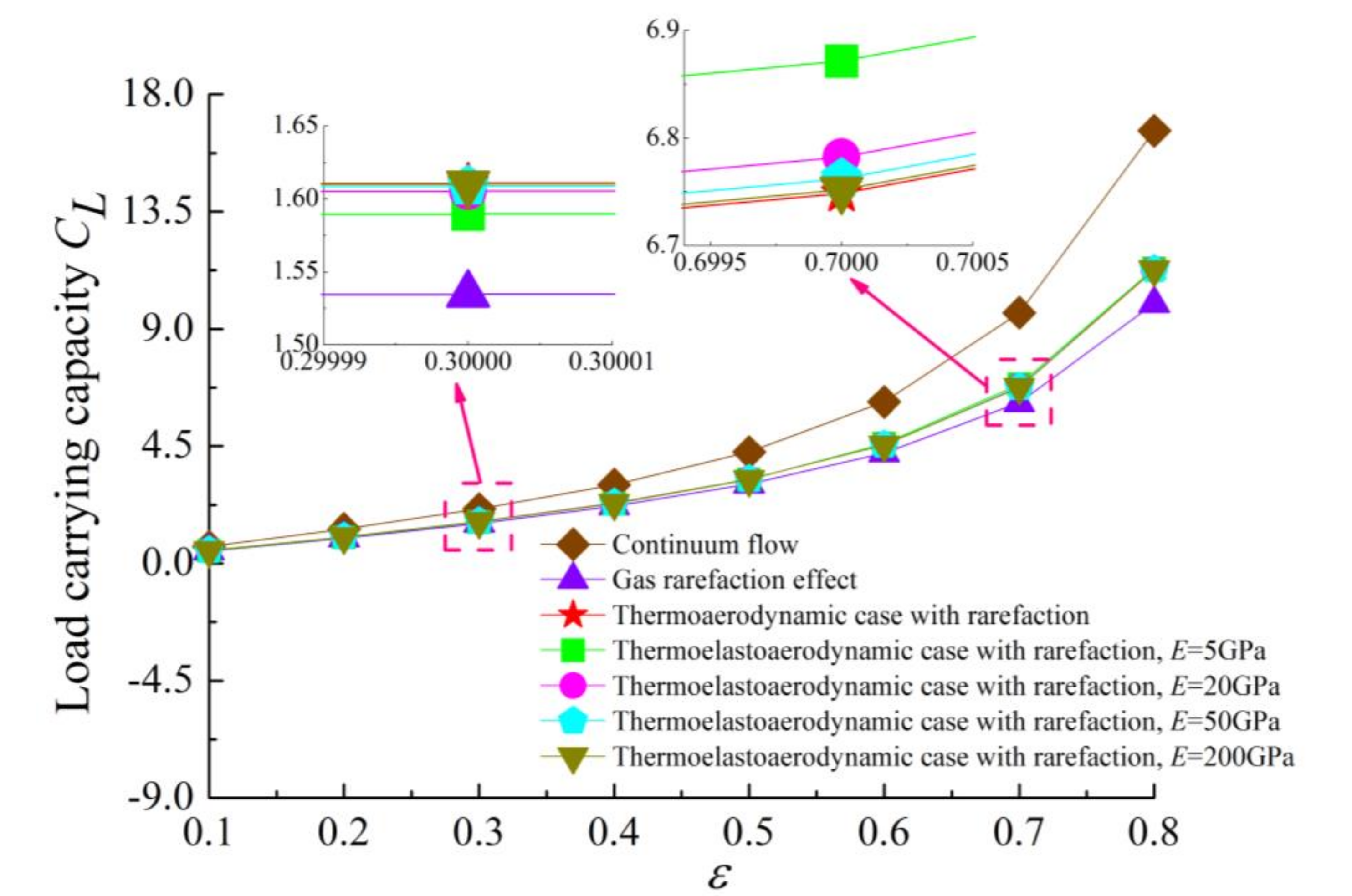
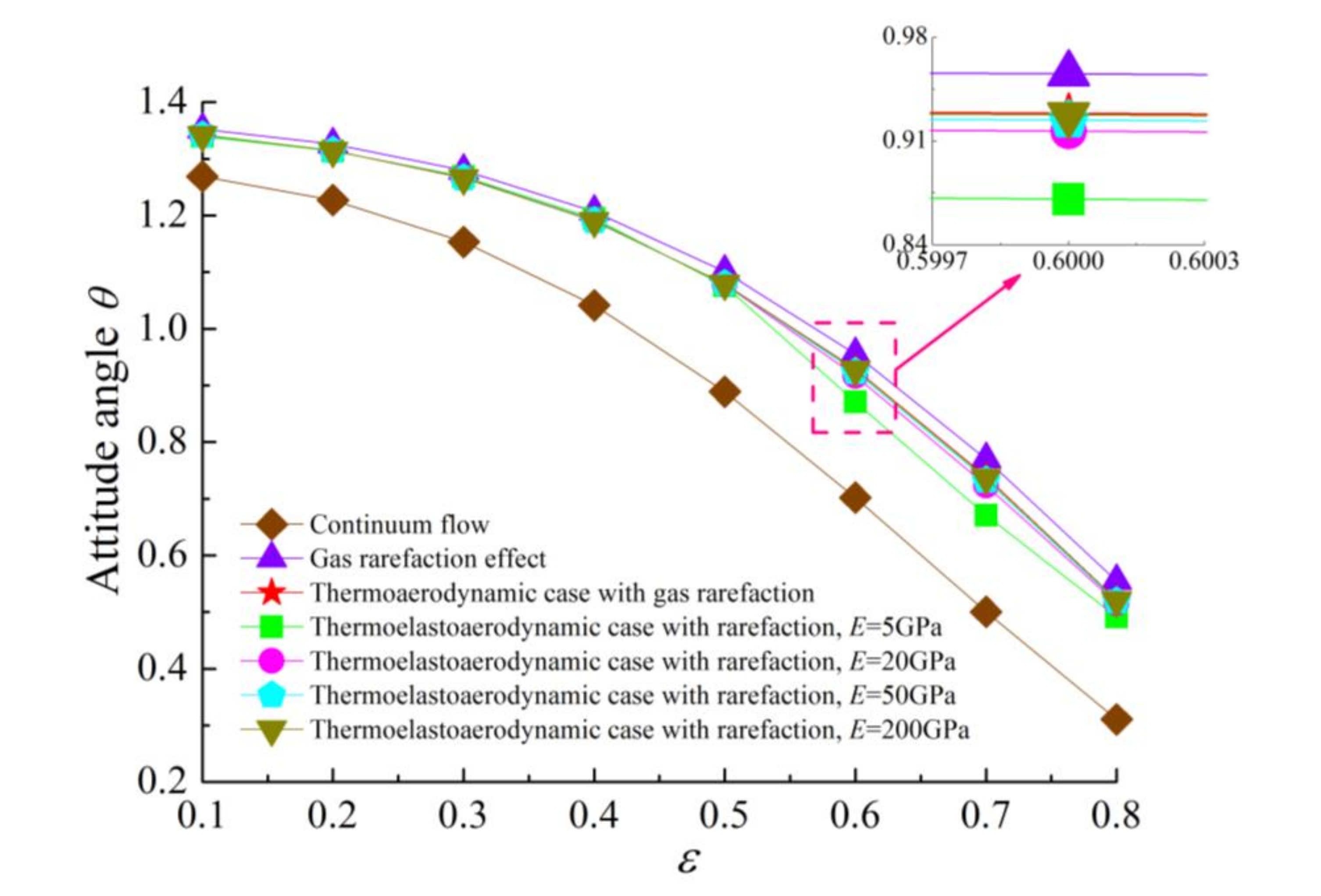
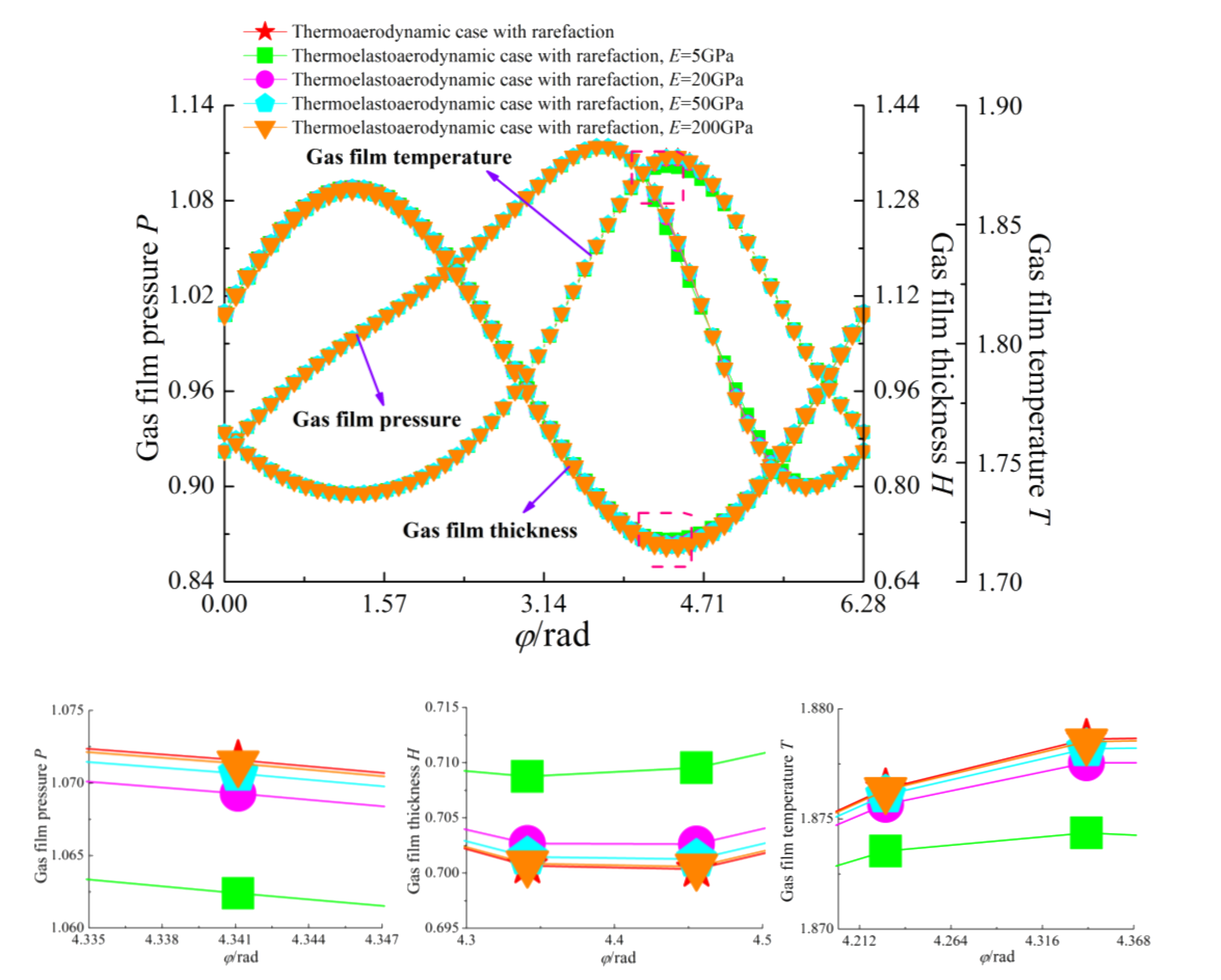



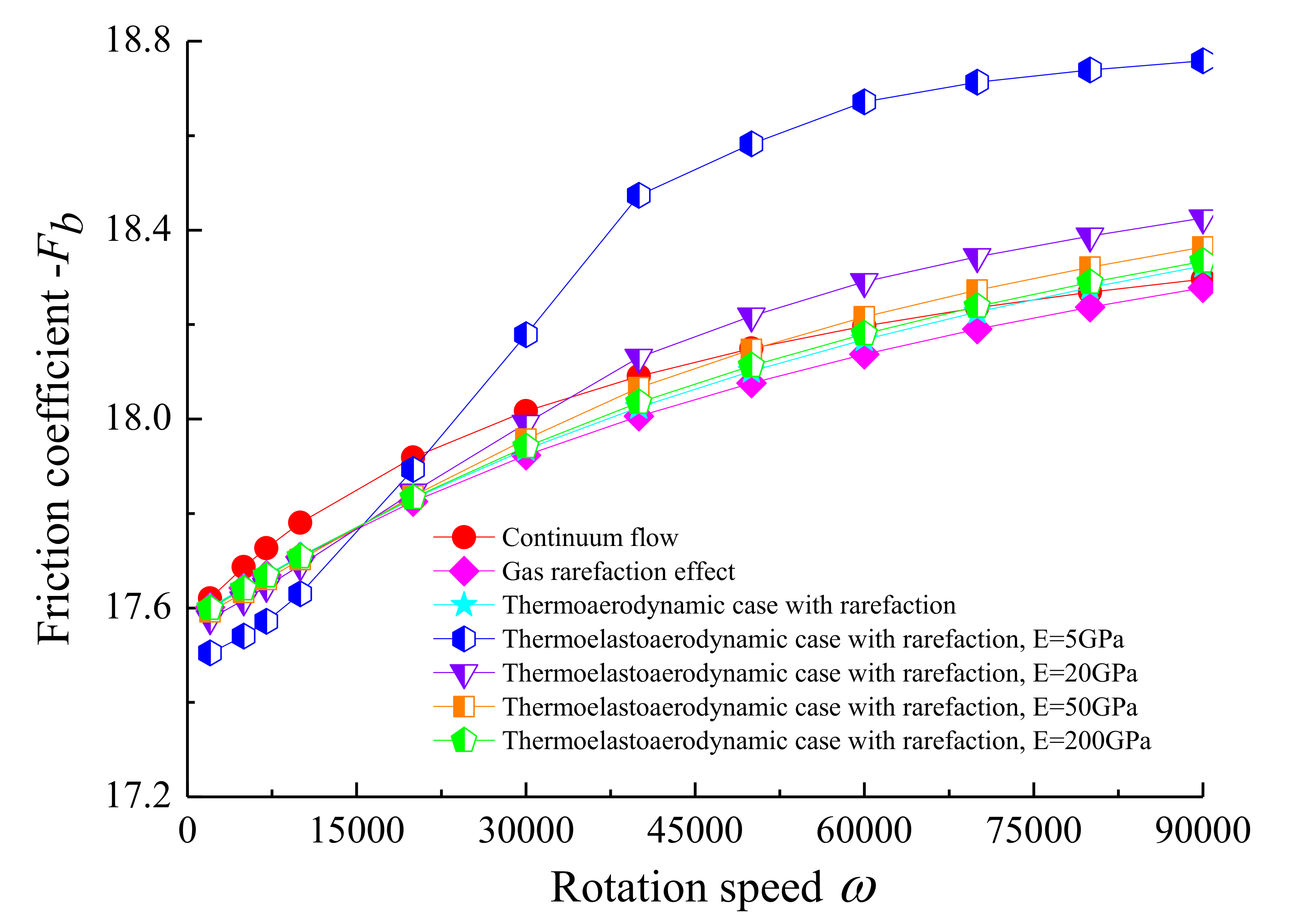
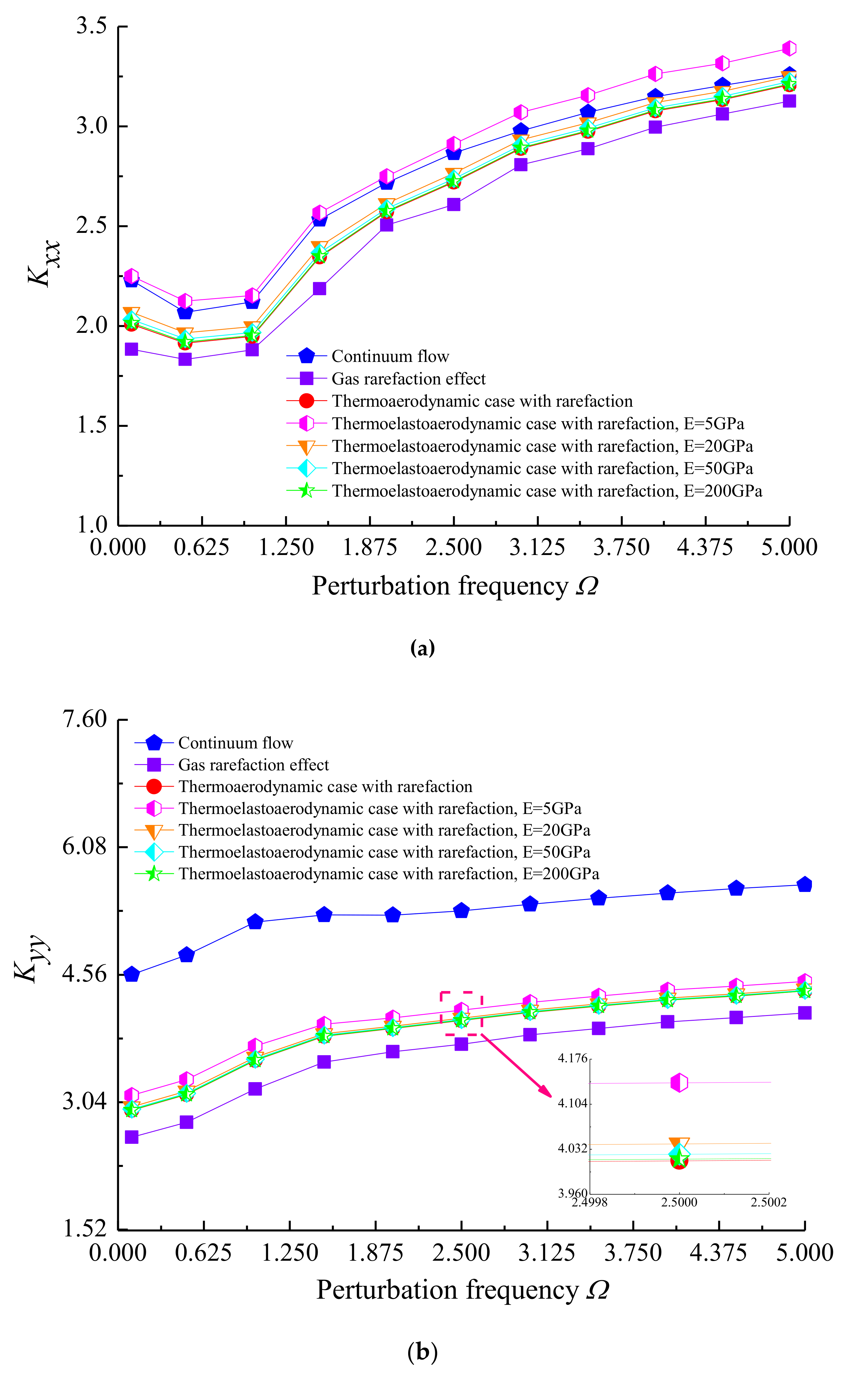
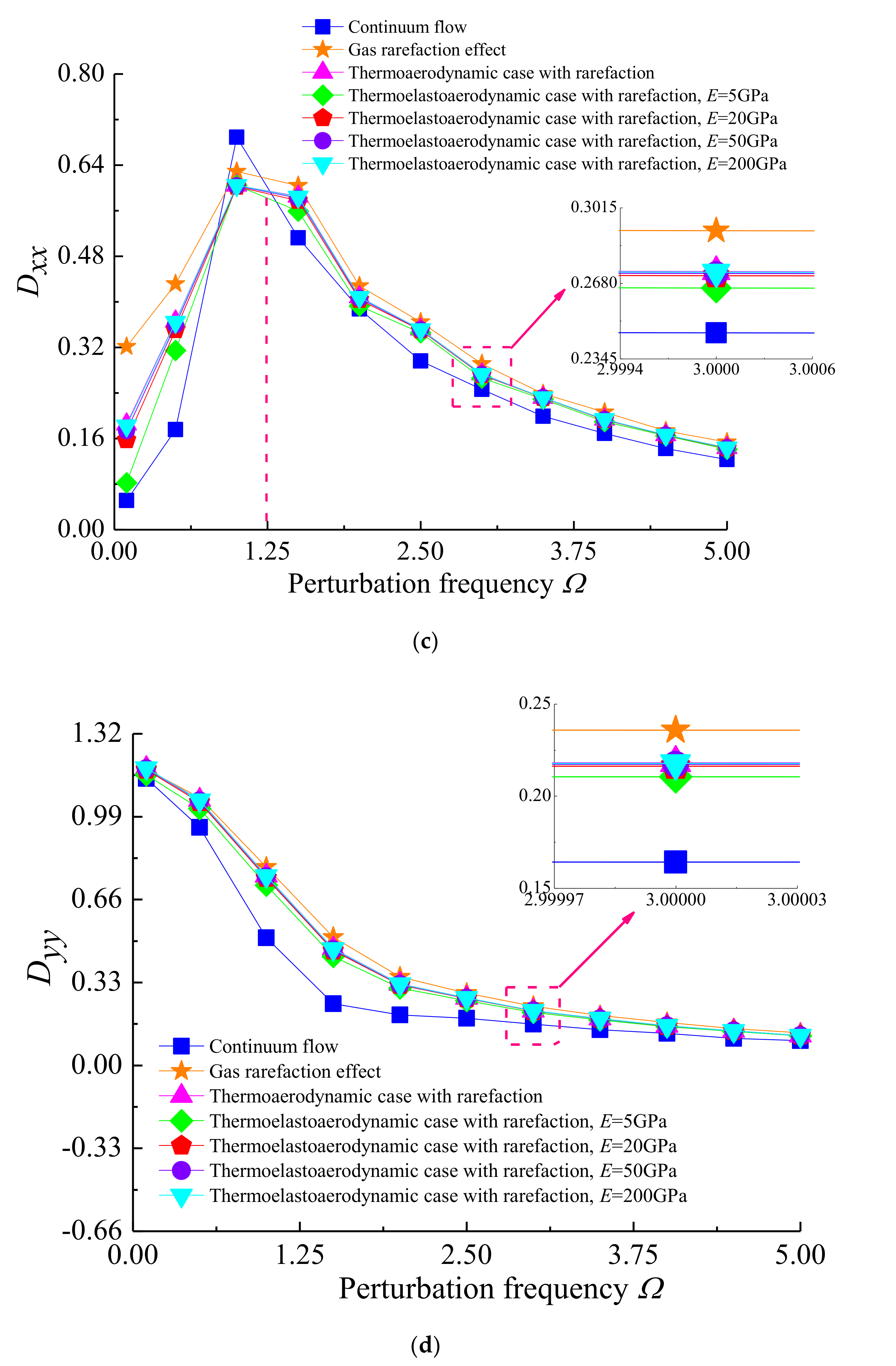
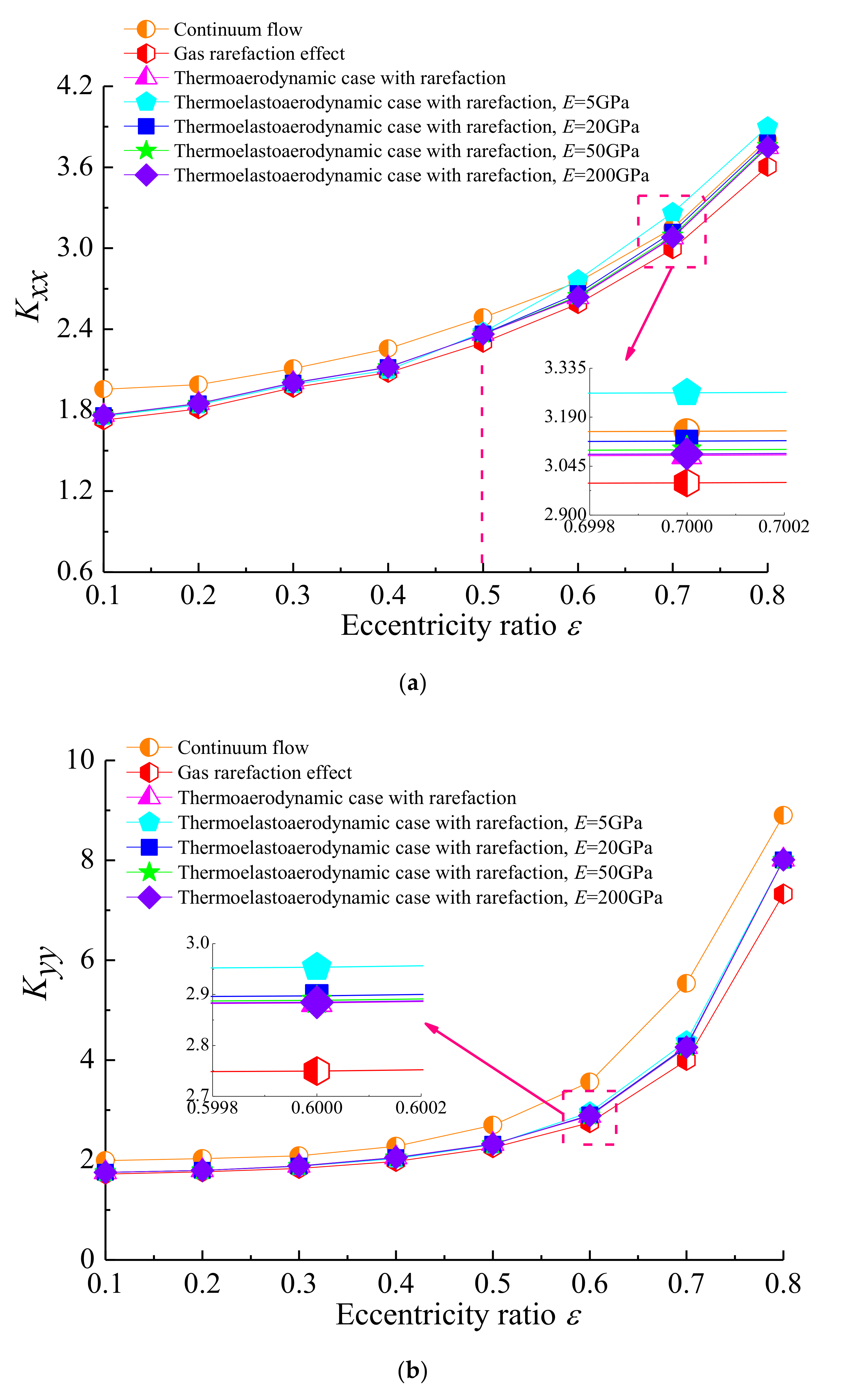
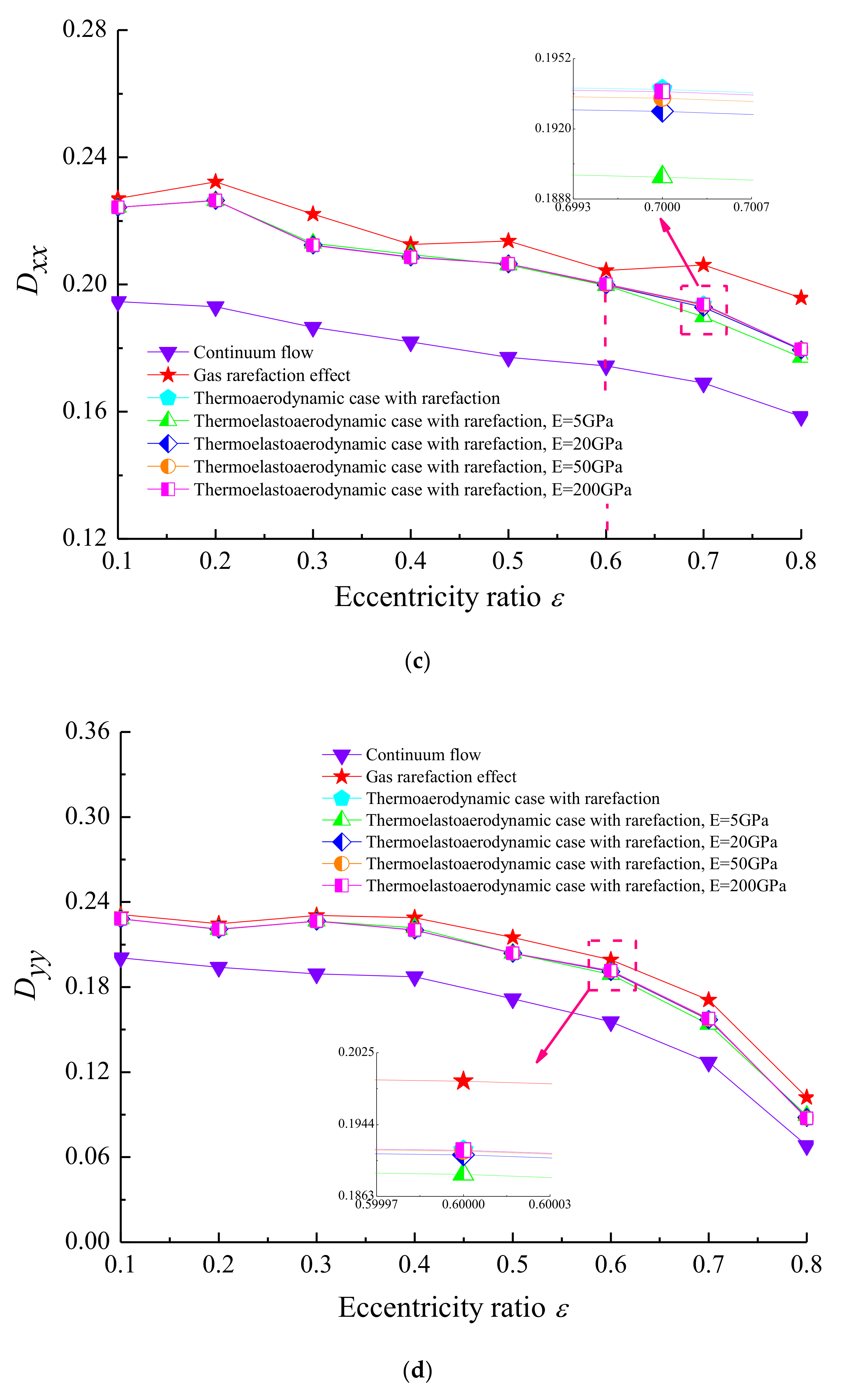
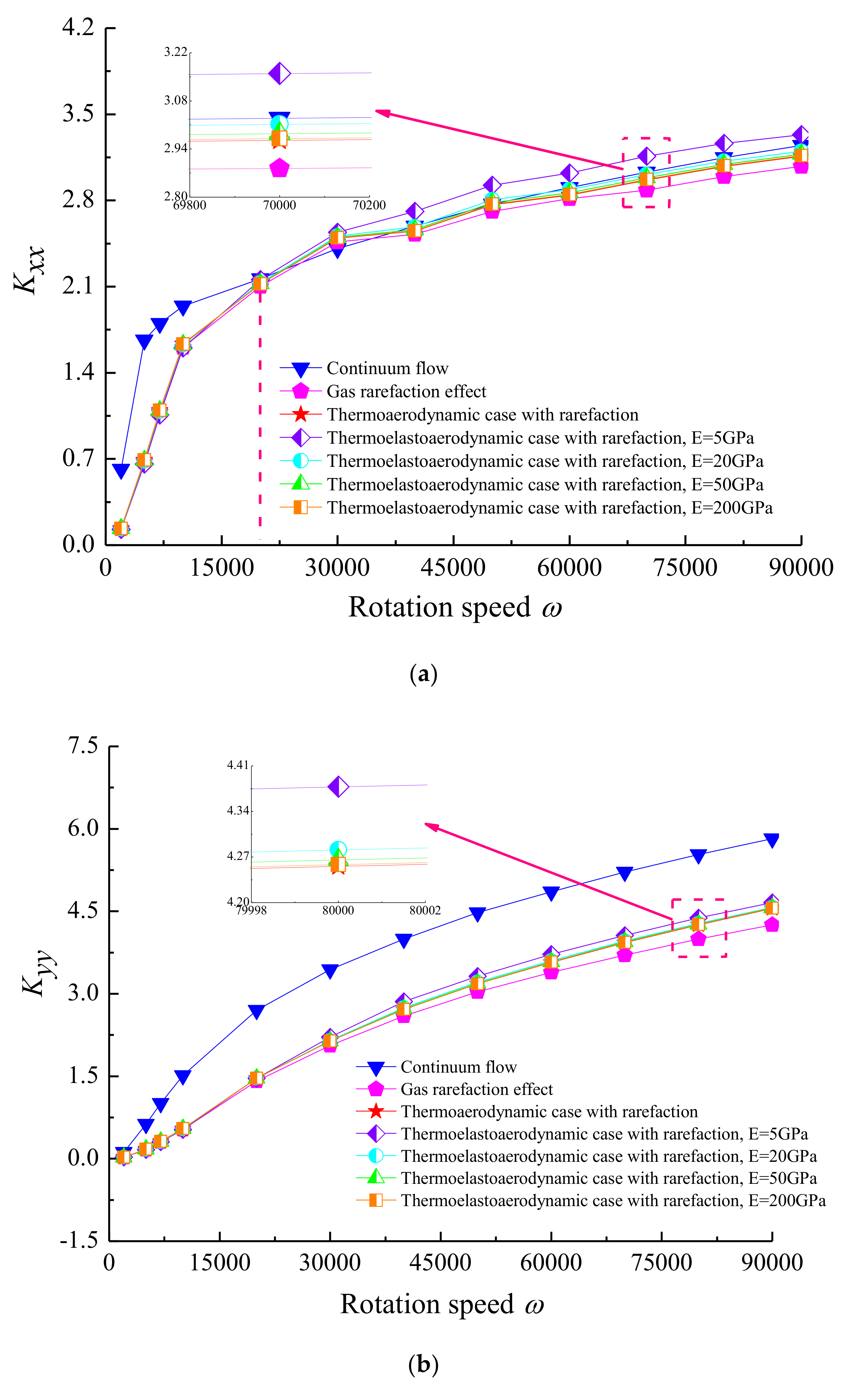

| Bearing Parameters | Values |
|---|---|
| Bearing radius R (mm) | 1 |
| Bearing length B (mm) | 0.2 |
| Ambient pressure pa (Pa) | 1.01 × 105 |
| Poisson’s ratio υ | 0.3 |
| Clearance spacing of the gas film c (µm) | 1 |
| Ambient temperature T0 (K) | 293.15 |
Publisher’s Note: MDPI stays neutral with regard to jurisdictional claims in published maps and institutional affiliations. |
© 2020 by the authors. Licensee MDPI, Basel, Switzerland. This article is an open access article distributed under the terms and conditions of the Creative Commons Attribution (CC BY) license (http://creativecommons.org/licenses/by/4.0/).
Share and Cite
Wu, Y.; Yang, L.; Xu, T.; Wu, W. Thermo-Elasto-Hydrodynamic Characteristics Analysis of Journal Microbearing Lubricated with Rarefied Gas. Micromachines 2020, 11, 955. https://doi.org/10.3390/mi11110955
Wu Y, Yang L, Xu T, Wu W. Thermo-Elasto-Hydrodynamic Characteristics Analysis of Journal Microbearing Lubricated with Rarefied Gas. Micromachines. 2020; 11(11):955. https://doi.org/10.3390/mi11110955
Chicago/Turabian StyleWu, Yao, Lihua Yang, Tengfei Xu, and Wei Wu. 2020. "Thermo-Elasto-Hydrodynamic Characteristics Analysis of Journal Microbearing Lubricated with Rarefied Gas" Micromachines 11, no. 11: 955. https://doi.org/10.3390/mi11110955
APA StyleWu, Y., Yang, L., Xu, T., & Wu, W. (2020). Thermo-Elasto-Hydrodynamic Characteristics Analysis of Journal Microbearing Lubricated with Rarefied Gas. Micromachines, 11(11), 955. https://doi.org/10.3390/mi11110955




